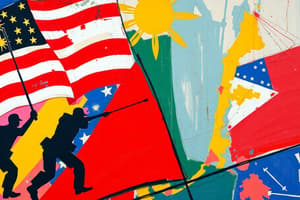Podcast
Questions and Answers
What was the main intention of President William McKinley regarding the Filipinos?
What was the main intention of President William McKinley regarding the Filipinos?
- To educate, uplift, civilize, and Christianize them (correct)
- To exploit the resources of the Philippines for the US
- To establish a military dictatorship in the Philippines
- To grant immediate independence to the Philippines
Which act prohibited Filipinos from expressing support for independence?
Which act prohibited Filipinos from expressing support for independence?
- Sedition Act (correct)
- Treason Act
- Brigandage Act
- Reconcentration Act
What role did William Howard Taft play in the American colonial government in the Philippines?
What role did William Howard Taft play in the American colonial government in the Philippines?
- He served as the chairman of the Philippine Commission (correct)
- He was the last governor-general before independence
- He was the first military governor of the Philippines
- He led a major revolt against American rule
What was the purpose of the Pacification campaign initiated by the US?
What was the purpose of the Pacification campaign initiated by the US?
What does the term 'bureaucratic government' refer to in the context of American colonial rule?
What does the term 'bureaucratic government' refer to in the context of American colonial rule?
What was the primary function of the Philippine Commission until 1907?
What was the primary function of the Philippine Commission until 1907?
What significant event occurred on October 16, 1907 in the Philippines?
What significant event occurred on October 16, 1907 in the Philippines?
Which act was designed to limit the formation of organizations or national movements by Filipinos?
Which act was designed to limit the formation of organizations or national movements by Filipinos?
What significant event allowed the United States to gain control of the Philippines?
What significant event allowed the United States to gain control of the Philippines?
What law abolished the Philippine Commission in 1916?
What law abolished the Philippine Commission in 1916?
Under the Jones Law, what powers were given to the Philippine Legislature?
Under the Jones Law, what powers were given to the Philippine Legislature?
What was the first phase of the Philippine-American War characterized by?
What was the first phase of the Philippine-American War characterized by?
What did Emilio Aguinaldo declare on June 12, 1898?
What did Emilio Aguinaldo declare on June 12, 1898?
What form of warfare did Filipinos shift to during the second phase of the conflict?
What form of warfare did Filipinos shift to during the second phase of the conflict?
Who was in command of the American forces against Aguinaldo during the conflict?
Who was in command of the American forces against Aguinaldo during the conflict?
What was one major consequence of the advanced weaponry of the U.S. army?
What was one major consequence of the advanced weaponry of the U.S. army?
Flashcards
Treaty of Paris (1898)
Treaty of Paris (1898)
The 1898 treaty that officially transferred control of the Philippines from Spain to the United States.
Americanization of the Philippines
Americanization of the Philippines
The American policy of assimilating Filipinos through education, civilization, and Christianization.
William Howard Taft
William Howard Taft
The first civil governor of the Philippines, appointed by President McKinley in 1901. He played a key role in establishing the American bureaucratic model of government.
Philippine Commission
Philippine Commission
Signup and view all the flashcards
Bureaucratic Government
Bureaucratic Government
Signup and view all the flashcards
Pacification Campaign
Pacification Campaign
Signup and view all the flashcards
Sedition Act (1901)
Sedition Act (1901)
Signup and view all the flashcards
Reconcentration Act (1903)
Reconcentration Act (1903)
Signup and view all the flashcards
Establishment of the Philippine Legislature (1916)
Establishment of the Philippine Legislature (1916)
Signup and view all the flashcards
Limitations on Philippine Legislative Powers (Jones Law)
Limitations on Philippine Legislative Powers (Jones Law)
Signup and view all the flashcards
Filipino Participation in Government under Jones Law
Filipino Participation in Government under Jones Law
Signup and view all the flashcards
First Philippine Republic and Resistance (1899-1902)
First Philippine Republic and Resistance (1899-1902)
Signup and view all the flashcards
Early Stages of the Philippine-American War (1899)
Early Stages of the Philippine-American War (1899)
Signup and view all the flashcards
Filipino Shift to Guerrilla Warfare
Filipino Shift to Guerrilla Warfare
Signup and view all the flashcards
Challenges Faced by Filipino Resistance
Challenges Faced by Filipino Resistance
Signup and view all the flashcards
US Control over the Philippines (1898-1902)
US Control over the Philippines (1898-1902)
Signup and view all the flashcards
Study Notes
American Colonialism in the Philippines
- The Philippines became part of the US after the Treaty of Paris in December 1898.
- The US paid Spain $20 million for the archipelago.
- William McKinley led the colonial administration, aiming to educate, civilize, and Christianize Filipinos.
- William Howard Taft was appointed first civil governor in 1901.
- The Philippine Commission, a legislative body, governed until 1907.
- A bureaucratic government model was introduced.
- Pacification campaigns were launched in response to Filipino revolts.
- Laws such as the Sedition Act (1901), Brigandage Act (1902), and Reconcentration Act (1903) were implemented.
Philippine-American War
- Emilio Aguinaldo declared Philippine independence in 1898, but it was challenged by the US.
- A revolutionary government fought against the US beginning in February 1899.
- Aguinaldo led his forces, initially attempting conventional warfare, but transitioned to guerilla tactics.
- The war ended in 1902 with Aguinaldo's capture.
Philippine Government Structure
- The Philippine Assembly was established as the lower house with Manuel L. Quezon as a leader
- The Philippine Commission functioned as the upper house.
- Together they formed the Philippine Legislature.
- The Jones Law of 1916 abolished the Philippine Commission
- The Philippine Legislature gained broad powers, although some laws needed US approval.
Studying That Suits You
Use AI to generate personalized quizzes and flashcards to suit your learning preferences.




